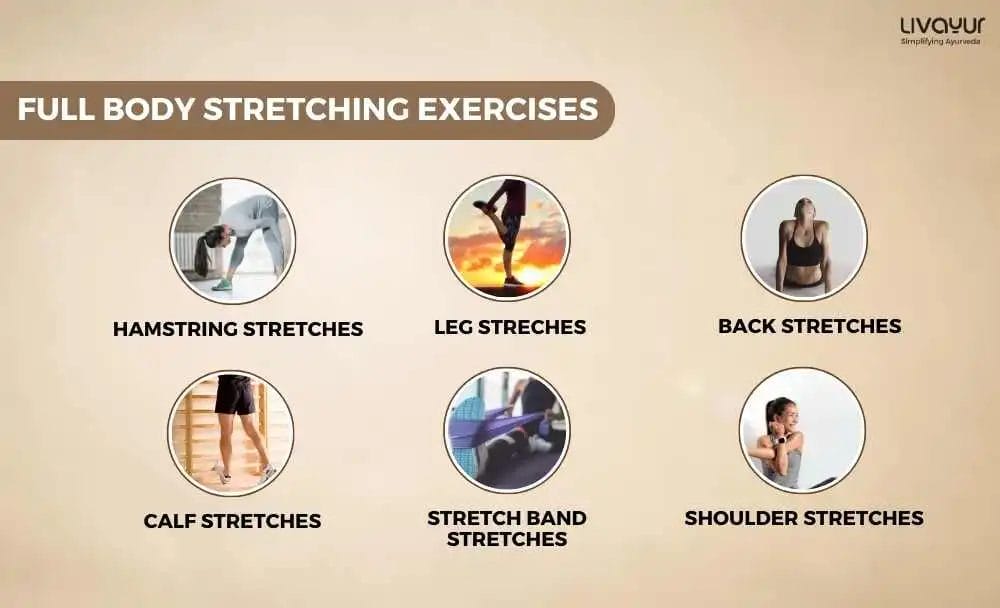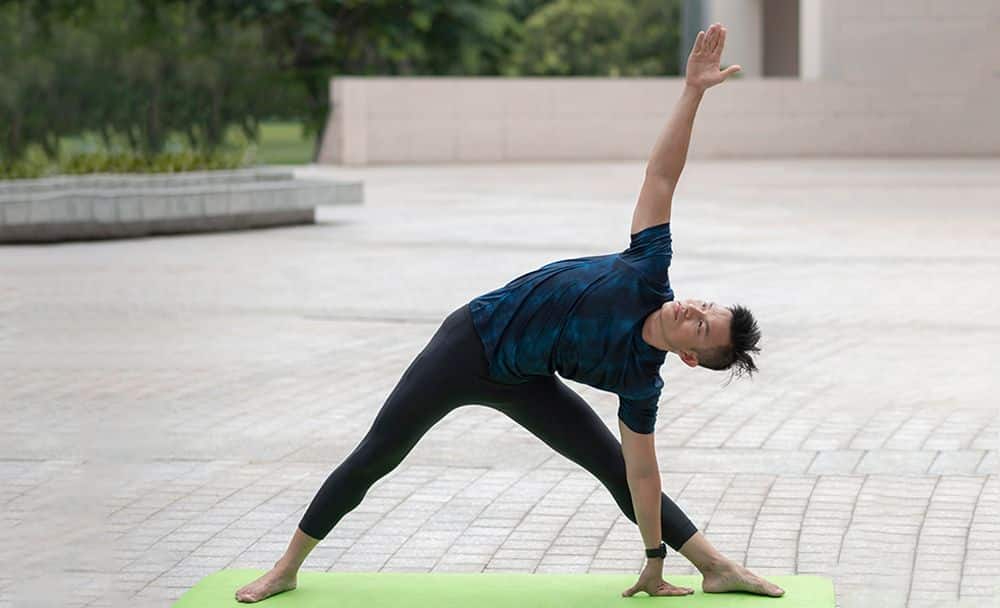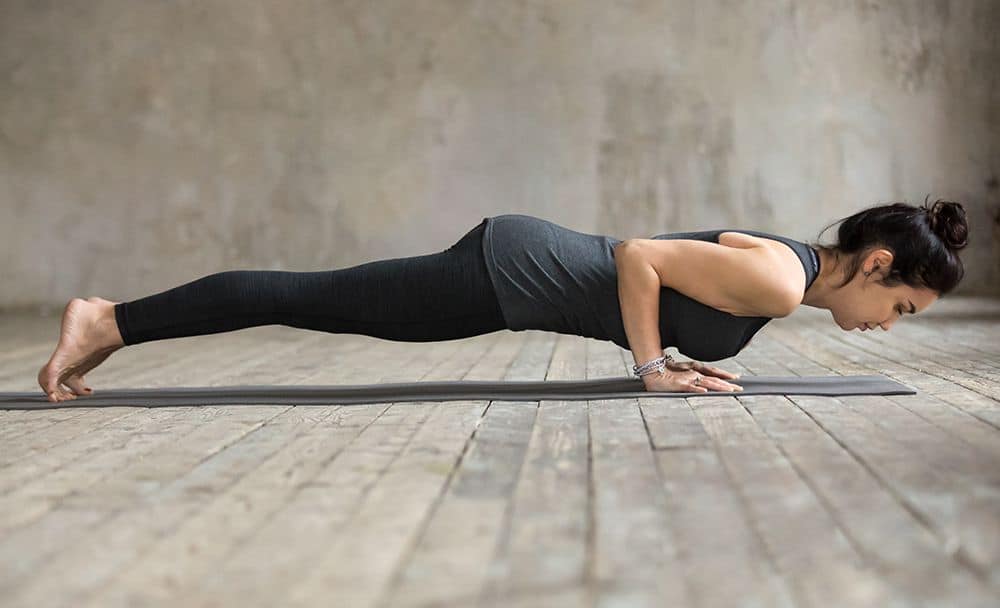
Stretching is essential to any fitness routine. It offers numerous benefits for the body and mind. Incorporating full-body stretching exercises into your regimen can work wonders. It doesn’t matter whether you’re an athlete or a gym enthusiast. The benefits are immense, as you can improve your flexibility.
From relieving muscle tension to enhancing range of motion, we look at 15 best stretching exercises. These exercises target all major muscle groups and promote a healthy physique. So, get ready to limber as we look at the most effective full-body stretches.
What is a full-body stretching exercise?
A full-body stretching exercise is a workout routine that engages and stretches all major muscle groups. Unlike isolated stretches that focus on specific areas, full-body stretching exercises aim to improve muscle coordination and increase overall mobility.
Incorporating stretches that target different muscle groups simultaneously helps optimize your workout and promote better body balance. Full-body stretching exercises provide a holistic approach to realizing your body’s true potential.
15 full-body stretching exercises to consider
Here are 15 exercises for full-body stretching you can incorporate into your fitness regimen:
- Stretching exercises for legs
Start with classic leg stretches like standing quad stretches and lunges. These exercises target the major muscles in your legs to promote flexibility and prevent tightness.
- Back stretching exercises
Take care of your back with exercises like the cat-camel stretch and child’s pose. These stretches help improve posture and increase mobility in the spine.
- Stretch band exercises
Incorporate stretch bands into your routine for added resistance and deeper stretches. Use the band to perform exercises like standing hamstring curls, chest and shoulder stretches, and assisted leg stretches.
- Stretching exercises to increase height
While genetics primarily determines height, specific stretching exercises can improve posture and help you reach your maximum height potential. Try exercises like the wall stretch, standing toe touches, and hanging exercises to elongate the spine and improve posture.
- Shoulder stretching exercises
Relieve shoulder tightness and improve flexibility with exercises like shoulder circles and shoulder rolls. These stretches target the muscles surrounding the shoulders to promote a range of motion and reduce stiffness.
- Neck stretching exercises
Combat neck tension and improve mobility with neck tilts and neck rotations. These exercises help release tightness and alleviate discomfort caused by poor posture.
- Hamstring stretching exercises
Stretching the hamstrings is crucial for maintaining lower body flexibility. Perform forward folds and seated forward bends to keep your hamstrings limber and prevent muscle imbalances.
- Calf stretching exercises
Keep your calf muscles supple and prevent cramps with standing raises and wall calf stretches. These exercises target the muscles in the lower leg to promote flexibility.
- Full-body stretching exercises
Engage your body with sun salutation, yoga flows, and Pilates stretches. These comprehensive routines incorporate stretches that target multiple muscle groups simultaneously.
- Cobra stretch exercise
The cobra stretch is an excellent exercise for stretching the entire front body, including the chest and shoulders. It also helps improve spinal mobility and relieve lower back discomfort.
- Hip flexor stretches
Target the hip flexor muscles with lunges and standing quad stretches. These stretches improve hip mobility and alleviate tightness in the front of the hips.
- Chest and shoulder opener
Open your chest and stretch your shoulders with doorway stretches and reverse prayer pose. These stretches counteract the effects of hunching and sitting for extended periods.
- Tricep stretches
Stretch the back of your upper arms with overhead tricep extensions and cross-body arm stretches. These stretches enhance flexibility and prevent tightness in the tricep muscles.
- Groin stretches
Improve flexibility in the groin area with butterfly stretches and seated wide-legged stretches. These stretches target the inner thigh muscles and help increase hip mobility.
- Full body yoga flow
Engage in a dynamic full-body stretching routine with a yoga flow sequence. A combination of downward dog, plank, upward dog, and warrior series will stretch and strengthen multiple muscle groups.

Precautions to know for full-body stretching exercise
While full-body stretching exercises offer numerous benefits, it’s essential to approach them with caution and prioritize safety. Here are some precautions to keep in mind before engaging in full-body stretching:
- Warm-up
Consider light cardio exercises like brisk walking or cycling for a few minutes. Warming up increases muscle blood flow to make them more pliable.
- Proper form
Maintain good posture, engage the correct muscles, and avoid excessive bouncing or jerking movements. These can lead to muscle strains or joint discomfort.
- Gradual progression
Begin with gentle stretches and increase the duration over time. Rushing into deep stretches or trying to push beyond your current limits can result in muscle strains or tears.
- Individual abilities
Understand that everyone has unique flexibility. Focus on your progress rather than comparing yourself to others. Respect your body’s unique capabilities and avoid pushing beyond what feels comfortable or causes pain.
- Breathing
Deep breaths can help relax the muscles and enhance the effectiveness of the stretches. Avoid holding your breath or straining during the stretches.
- Injury awareness
Consult a healthcare professional or physical therapist before attempting full-body stretching exercises if you have any existing injuries or chronic conditions. They can recommend modifications that suit your needs.
- Avoid pain
Stretching should never cause sharp or intense pain. It is normal to feel mild discomfort. However, stop the stretch immediately if you experience severe pain or joint instability. Pushing through pain can lead to further injury or worsen existing conditions.
- Balance and stability
Maintain proper balance during stretches by using support if necessary. For example, a chair or wall can assist with balance-intensive stretches.
- Consistency
Incorporate full-body stretching exercises into your routine regularly to maximize their benefits. Consistency is critical for improving range of motion and muscle coordination.
Full-body stretching exercises and yoga
Full-body stretching exercises and yoga go hand in hand in promoting flexibility and strength. Yoga combines physical postures, breathing techniques, and meditation. From sun salutations and warrior poses to seated twists and forward bends, yoga poses engage and stretch multiple muscle groups simultaneously.
The flowing sequences and mindful focus in yoga also enhance body awareness and encourage proper alignment. Moreover, the meditative aspect of yoga promotes mental clarity and relaxation. Yoga practices offer a holistic approach to both physical and psychological wellness.

FAQs
1. Are full-body stretches good?
Full-body stretches are highly beneficial. They improve flexibility, enhance range of motion, prevent muscle imbalances, promote better posture, and reduce the risk of injury. Full-body stretches engage multiple muscle groups simultaneously for a comprehensive approach to maintaining physical wellbeing.
2. What are the three hardest stretches to perform?
The difficulty of stretches can vary depending on individual flexibility and strength. However, some challenging stretches include splits, deep backbends, and advanced inversions.
3. How can I stretch my whole body?
Incorporate various stretches that target different muscle groups to stretch your whole body. Include sun salutations or yoga flows, which engage the entire body. Additionally, perform stretches for the legs, back, shoulders, neck, hamstrings, calves, and other major muscle groups to ensure a comprehensive full-body stretch routine.
4. Which stretching method is most effective?
The most effective stretching method depends on individual preferences and goals. However, dynamic stretching, which involves moving through stretches with controlled movements, helps warm the body and improve the range of motion before physical activity. Static stretching, where stretches are held for a while, increases flexibility.
5. Should you stretch every day?
Stretching can be beneficial, but listening to your body and finding a routine that works for you is essential. Regular stretching can help maintain flexibility and prevent muscle tightness. However, avoiding overstretching or pushing beyond your limits is crucial, as this can lead to injury.
6. Which is better, stretching or workout?
Stretching and working out serve different purposes and have their benefits. Stretching improves flexibility and range of motion. Working out, on the other hand, strengthens muscles and improves cardiovascular health. Ideally, a well-rounded fitness routine should include stretching and workouts to optimize physical wellbeing.
Conclusion
Incorporating full-body stretching exercises into your fitness regimen is wise for anyone seeking improved flexibility and enhanced mobility. Targeting multiple muscle groups allow these exercises to provide a comprehensive approach to stretching and promoting balance.
Remember to warm up, maintain proper form, and listen to your body’s signals to prevent injuries. Following the precautions and integrating full-body stretching exercises will help you realize your body’s potential and optimize your fitness journey.
Disclaimer
The information provided here does not mean to replace professional advice or treatment.
















